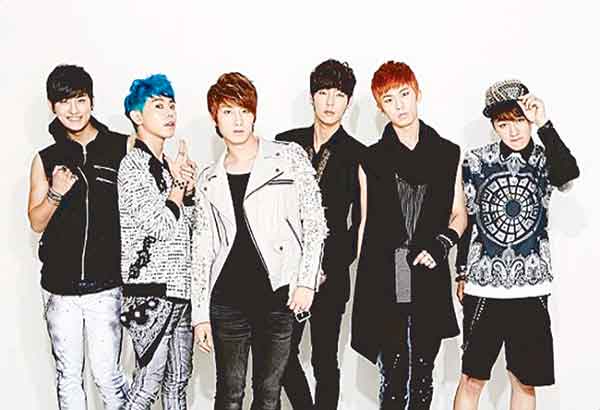A festival for all things Hallyu
MANILA, Philippines – The wild screams began as soon as Korean pop group FameUs (pronounced famous) waved hello. The six-member boy group was just formed last year but it already has a strong fan base in the country. FameUS was one of the Korean artists who performed at the 2015 Philippines-Korea Cultural Exchange Festival last Oct. 4 at the Newport Performing Theater in Resorts World Manila.
As the group sang a Tagalog song Mahal na Mahal by Sam Concepcion, the audience members screamed from the floor.

FameUS was one of the Korean artists who performed at the festival
“I really love them, I follow them on YouTube and attend their shows here,” says Jocelyn Pangilinan, a devoted K-pop fan since 2012.
But more than the performances of K-pop artists that night, including girl group Asha, Jocelyn and her friends confessed that they’ve also enjoyed the song-and-dance performances of other artists, particularly the Yeonhee Company UEE. The Korean traditional group consists of young professional artists who streamline traditional performances by encouraging the audience to be involved.
At the start of their performance, a rotund man with a set of drums asked the crowd to say a bunch of syllables “Hoo-Ha” and clap their hands. The audience happily obliged.
The Yeonhee Company UEE then proceeded to deliver five well-choreographed and synchronized dance numbers, and even did back flips to the delight of the audience. The boys wore hats with ribbons that spin once they move on the stage, creating a nice visual effect. One of the hosts couldn’t help but compare UEE to British percussion group Stomp. Stomp uses the body and ordinary objects to create a physical theater performance.
“Koreans are really good dancers, they’re very graceful,” said Liezl Junio, another K-pop fan.
The event is a festival for all things hallyu or the Korean wave of culture sweeping into Asia and the West but that night, it was more of a celebration of the friendship between the Philippines and Korea.
At the beginning of the program, both the Philippine and Korean national anthems were performed by the Philippines-Korea United Choir, which was composed of 200 Filipino and Korean choir members.
The Philippine culture was highlighted by the performance of the Ramon Obusan Folkloric Group. Founded by National Artist Ramon Obusan in the ’70s, the group continues to perform original Filipino folk dances. Since 1986, the group has been one of Cultural Center of the Philippines’ leading resident companies and has presented over a a thousand traditional folk dance performances abroad.
One of the highlights of the event was the presentation of Korea’s well-loved musical play Chunhyang-jeon, a pansori folk tale similar to the story of Shakespeare’s Romeo & Juliet.
Nobody noticed that the actors were students of the Korean Cultural Center (KCC) in the Philippines until one teener committed a mistake and spoke in Tagalog. For six months, the students practiced daily to perfect their Korean (language and accent), internalized their characters and memorized by heart their lines and the songs from the play.
Young Pinoys, out of their love for K-pop artists, enroll at the KCC for Korean language classes, Taekwondo, cooking classes and K-pop dance lessons. For the fans, obsession with K-pop stars weaves its way into everyday life, affecting what they watch, eat and wear. They learn to speak the language and patronize everything that is branded Korean. What was notable during the play was the beautiful Hanbok costumes the students wore. We learned it was designed by one of the top Hanbok fashion designers in Korea.
After the dance and theatrical performances, the competitions took place, such as the Speech and Talent competition for Filipino and Korean participants. The competition showcased Filipinos performing in Korean and Koreans performing in Filipino. Preliminary rounds were held last September.
For the speech contest, Kevin Basco won the Korea Speech Category and CHOI Yeonjin won the Filipino category. Each received a trip for two to Korea.
In the talent category, six-member dance group Nemexis Crew won the grand prize with P50,000. Filipino Saxophone Team, ERA and 24-Minute won the first, second and third place, respectively.
A fashion show featuring the Hanbok and a Korean photo exhibit were also prepared for the audience.
Korean Ambassador to the Philippines Kim Jae-Shin said he was very pleased with the increasing cultural exchange activities of both countries.
“More and more Filipinos are becoming fond of Korean food, K-Pop dance and music, and Korean films and TV shows. With the growing popularity of Hallyu among many Filipinos, this cultural exchange festival will serve to further enhance the cordial relationship between Korea and the Philippines,” said Ambassador Kim.
The National Commission for Culture and the Arts (NCCA) OIC-executive director, Adelina Suemith, for her part said: “Through this festival, we celebrate that which unites us, while at the same time, draw attention to our own unique cultural gifts. We hope that the performances featured would inspire us to delve deeper into the wealth of our own traditions, to enforce a better understanding of each other.”
The Philippines-Korea Cultural Exchange Festival is an annual event hosted by KCC and the Embassy of Republic of Korea together with the United Korean Community Association in the Philippines (UKCA) and the NCCA.
“This event aims to have a better understanding of both countries’ culture and tradition through the musical performances and various cultural activities,” the KCC said in a statement. Last Sept. 24 and 27, the regional leg of the Cultural Exchange Festival was held in the cities of Iloilo and Baguio.
- Latest
- Trending





























